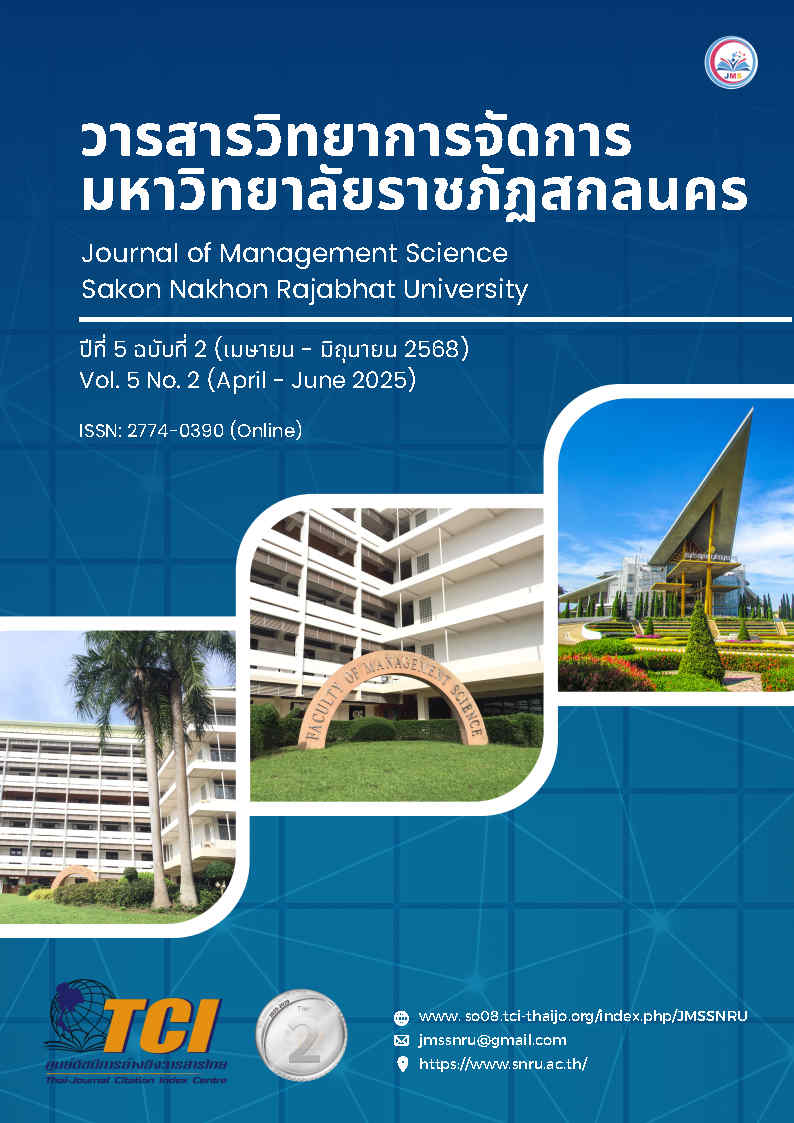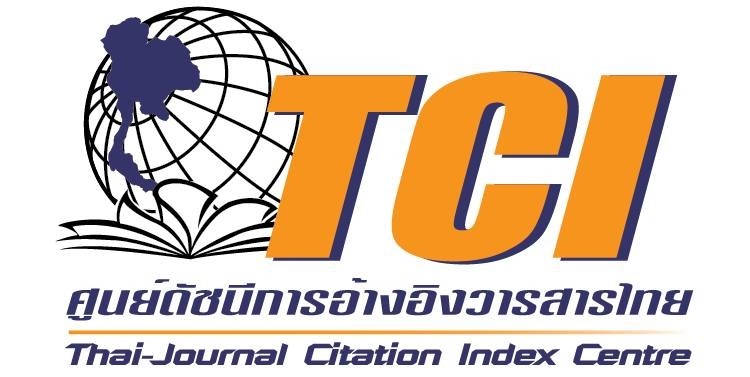รูปแบบการจัดการชุมชนคุณธรรมขับเคลื่อนด้วยพลังบวรต้นแบบของชุมชนคุณธรรม บ้านท่าเรือ ตำบลท่าเรือ อำเภอนาหว้า จังหวัดนครพนม
คำสำคัญ:
รูปแบบการจัดการชุมชน, ชุมชนคุณธรรม, พลังบวร, ต้นแบบบทคัดย่อ
ชุมชนคุณธรรมขับเคลื่อนด้วยพลังบวรต้นแบบบ้านท่าเรือ เป็นชุมชนที่รับการส่งเสริมจนเกิดเป็นชุมชนคุณธรรมต้นแบบ ที่เข้มแข็งสามารถพึ่งพาตนเองได้ ได้รับความร่วมมือจากผู้นำพลัง “บวร” (บ้าน วัด โรงเรียน/ราชการ) ซึ่งเป็นองค์ประกอบหลักของชุมชนคุณธรรมที่สำคัญ เพื่อดำเนินกิจกรรมที่ก่อให้เกิดการมีส่วนร่วมในชุมชนที่ยั่งยืน การวิจัยครั้งนี้มีวัตถุประสงค์ 1) เพื่อศึกษารูปแบบการขับเคลื่อนชุมชนคุณธรรมด้วยพลังบวรต้นแบบของชุมชนคุณธรรมบ้านท่าเรือ ตำบลท่าเรือ อำเภอนาหว้า จังหวัดนครพนม 2) เพื่อศึกษาภาวะผู้นําชุมชน วัด โรงเรียน ราชการ และการมีส่วนร่วม ในการขับเคลื่อนชุมชนคุณธรรมด้วยพลังบวรต้นแบบของชุมชนคุณธรรม บ้านท่าเรือ ตำบลท่าเรือ อำเภอนาหว้า จังหวัดนครพนม 3) เพื่อศึกษาปัญหา อุปสรรค และข้อเสนอแนะแนวทาง ในการดำเนินงานการขับเคลื่อนชุมชนคุณธรรมด้วยพลังบวรต้นแบบของชุมชนคุณธรรมบ้านท่าเรือ ตำบลท่าเรือ อำเภอนาหว้า จังหวัดนครพนม ผู้วิจัยใช้วิธีการวิจัยเชิงคุณภาพ การเก็บรวบรวมข้อมูลในชุมชนคุณธรรมต้นแบบ จำนวน 1 ชุมชน บ้านท่าเรือ ตำบลท่าเรือ อำเภอนาหว้า จังหวัดนครพนม เครื่องมือที่ใช้ในการวิจัย เป็นแบบสัมภาษณ์แบบมีโครงสร้าง (structured interview) ด้วยวิธีการสัมภาษณ์เชิงลึก ผู้ให้ข้อมูลเป็นผู้นำชุมชน ปราชญ์ชาวบ้าน พระสงฆ์ ครู ข้าราชการสังกัดสำนักงานวัฒนธรรมจังหวัดนครพนม ผลการวิจัยพบว่า รูปแบบการจัดการชุมชนคุณธรรมขับเคลื่อนด้วยพลังบวรต้นแบบของชุมชนคุณธรรม บ้านท่าเรือ ตำบลท่าเรือ อำเภอนาหว้า จังหวัดนครพนม ได้แก่ บ้าน วัด โรงเรียน และหน่วยงานภาครัฐ (บวร) ร่วมกันขับเคลื่อนกิจกรรมต่าง ๆ ให้ทุกภาคส่วนเข้ามามีส่วนร่วมอย่างสร้างสรรค์ อย่างต่อเนื่อง เพื่อขับเคลื่อนหลักปรัชญาของเศรษฐกิจพอเพียง แนวทางดำเนินการ คือ การส่งเสริมการมีส่วนร่วมของทุกภาคส่วน และการบูรณาการในด้านกิจกรรม การติดตามประเมินผล กลยุทธ์ในการแก้ไขปัญหาของชุมชน ควรเน้นการมีส่วนร่วมของทุกภาคส่วนการบูรณาการ การพัฒนาศักยภาพ และการพัฒนาอย่างยั่งยืน แนวทางในการส่งเสริมการมีส่วนร่วม ได้แก่ การสร้างความรู้ความเข้าใจ การสร้างแรงจูงใจ โดยการเชิดชู ยกย่อง และการสนับสนุนทรัพยากร ผู้นำวัด โรงเรียน และราชการ ให้การสนับสนุนงบประมาณ อุปกรณ์ สถานที่ในการจัดกิจกรรมต่าง ๆ ของชุมชนสนับสนุนการพัฒนาทักษะ ความรู้ ของผู้นำ ชาวบ้าน และสนับสนุนการสร้างเครือข่ายความร่วมมือกับหน่วยงานต่าง ๆ ปัญหา อุปสรรค และแนวทางในการแก้ไขในการขับเคลื่อนชุมชนคุณธรรมขับเคลื่อนด้วยพลังบวรต้นแบบของชุมชนคุณธรรม บ้านท่าเรือ ตำบลท่าเรือ อำเภอนาหว้า จังหวัดนครพนม ดังนี้ ปัญหาการทะเลาะวิวาทกัน การพนัน ยาเสพติด หนี้สินนอกระบบ ดื่มเหล้า ขยะ สิ่งแวดล้อมถูกทำลาย ผู้สูงอายุถูกทอดทิ้ง และการแสดงที่ไม่เหมาะสมในงานบุญประเพณี โดยมีแนวทางในการแก้ไข คือ ทุกคนต้องมีส่วนร่วมในการขับเคลื่อนชุมชนคุณธรรมครั้งนี้ เพราะการที่ชุมชนมีส่วนร่วมในกิจกรรมของโครงการนับเป็นความสำเร็จอย่างยิ่งของโครงการ เพราะท้ายที่สุดแล้วเป้าหมายของโครงการชุมชนคุณธรรม คือ การที่ชุมชนมีความสุข คือ ปัญหาเชิงคุณธรรมของชุมชนลดลง คนในชุมชนสามารถดำเนินชีวิตได้อย่างมีความสุข ไม่เป็นหนี้ และสามารถพึ่งตนเองได้รวมตลอดถึงสามารถเป็นที่ศึกษาดูงานเป็นต้นแบบให้กับชุมชนอื่นๆ ได้
เอกสารอ้างอิง
กรมการศาสนา กระทรวงวัฒนธรรม. (2561). คู่มือการขับเคลื่อนแผนแม่บทส่งเสริมคุณธรรมแห่งชาติ ฉบับที่ 1 (พ.ศ. 2559-2564). กรุงเทพฯ: รำไพเพรส.
ธธงชัย สารอักษร. (2563). แนวทางการพัฒนาชุมชนคุณธรรมน้อมนำหลักปรัชญาของเศรษฐกิจพอเพียง กรณีศึกษาชุมชนวัดกาฬสินธุ์ (บ้านน้ำดำ) ตำบลประสงค์ อำเภอท่าชนะ จังหวัดสุราษฎร์ธานี. วารสารรัฏฐาภิรักษ์, 62(2), 41-54.
พระครูพิสุทธิปัญญาภิวัฒน์ (ณพณัฐ กิตฺติปญฺโญ), พระอุดมสิทธินายก (กำพล คุณงฺกโร) และพระปลัดระพิน พุทฺธิสาโร. (2565). รูปแบบการบริหารจัดการจังหวัดคุณธรรมต้นแบบของจังหวัดพิจิตร. วารสาร มจร สังคมศาสตร์ปริทรรศน์, 11(1), 305-318.
พระณัฏฐ์ธนชัย จันดาผล, พระพรสวรรค์ ใจตรง, พระกัญจน์ แสงรุ่ง และพระจรัญ สุวโจ. (2563). การศึกษาการขับเคลื่อนชุมชนคุณธรรมด้วยพลังบวรของวัดจำปา อำเภอกันทรารมย์ จังหวัดศรีสะเกษ. วารสาร มจร อุบลปริทรรศน์, 5(1), 183-193.
พระศิระ จิตฺตสุโภ (พิเชฐสกุล). (2563). การศึกษารูปแบบชุมชนคุณธรรมต้นแบบด้วยพลังบวร: กรณีศึกษาวัดท่าขนุน อำเภอทองผาภูมิ จังหวัดกาญจนบุรี. วิทยานิพนธ์พุทธศาสตรมหาบัณฑิต สาขาวิชาพระพุทธศาสนา มหาวิทยาลัยมหาจุฬาลงกรณราชวิทยาลัย.
พระอธิการโสภณ ปิยธมฺโม (กิ่งแก้ว), ละเอียด จงกลนี และพระฮอนด้า วาทสทฺโท (เข็มมา). (2564). พลังบวร: พลังหลักของชุมชนคุณธรรม. วารสารปัญญาปณิธาน, 6(1), 69–80.
วิโรจน์ ก่อสกุล. (2561). เอกสารประกอบการบรรยายกระบวนวิชาองค์การและนวัตกรรมในองค์การ. โครงการรัฐประศาสนศาสตรมหาบัณฑิต มหาวิทยาลัยรามคำแหง.
สุดา นุ่นปาน. (2563). การศึกษาการขับเคลื่อนชุมชนคุณธรรมด้วยพลังบวรของสำนักงานวัฒนธรรมจังหวัดปทุมธานี. การค้นคว้าอิสระรัฐศาสตรมหาบัณฑิต สาขาวิชาการเมืองการปกครอง สำหรับนักบริหารคณะรัฐศาสตร์ มหาวิทยาลัยธรรมศาสตร์.
สุทัศน์ ประทุมแก้ว, พระครูปริยัติคณานุรักษ์ ศรีสมงาม, พระวีระพงษ์ โคษา และจักร์กฤษ ทองมี. (2564). พลังบวรในการขับเคลื่อนชุมชนคุณธรรมเชิงพุทธในสังคมไทย. วารสารวิชาการ มจร บุรีรัมย์, 6(2), 346 – 359.
สุภางค์ จันทวานิช. (2561). วิธีวิจัยเชิงคุณภาพ (พิมพ์ครั้งที่ 24). กรุงเทพฯ: สำนักพิมพ์แห่งจุฬาลงกรณ์มหาวิทยาลัย.
สำนักงานปลัดกระทรวงวัฒนธรรม กระทรวงวัฒนธรรม. (2562). คู่มือส่งเสริมและพัฒนาองค์กร ชุมชน อำเภอ และจังหวัดคุณธรรม. กรุงเทพฯ: โรงพิมพ์ชุมนุมสหกรณ์การเกษตรแห่งประเทศไทย.
สํานักงานวัฒนธรรม จังหวัดระยอง. (2563). เสน่ห์ชุมชน “พลังบวร/บรม” คนดี สังคมดี อยู่ดี มีสุข. หนังสืออิเล็กทรอนิกส์. https://anyflip.com/chvzx/bwsg/basic.
เอกสิทธิ์ คล้ายแดง. (2560). การนำนโยบายการขับเคลื่อนชุมชนคุณธรรมด้วยพลังบวร (บ้าน-วัด-โรงเรียน) มาใช้พัฒนาศูนย์ศึกษาพระพุทธศาสนาวันอาทิตย์ กรณีศึกษาศูนย์ศึกษาพระพุทธศาสนาวันอาทิตย์วัดนาคปรก เขตภาษีเจริญ กรุงเทพมหานคร. การค้นคว้าอิสระรัฐประศาสนศาสตรมหาบัณทิต มหาวิทยาลัยรามคำแหง.
Burns, J. M. (1978). Leadership. New York: Harper & Row.
Cohen, J. M., & Uphoff, N.T. (1977). Rural Development Participation: Concept and Measure for Project Design Implementation and Evaluation: Rural Development Committee Center for international Studies. Rural Development Committee, Center for International Studies, Cornell University Press.
Fevre, R. (2000). Socializing social capital: identity, the transition to work, and economic development. In S. Baron, J. Field, & T. Schuller (Eds.), Social capital: Critical perspectives. London: Oxford University Press.
Gilbert, G. E., & Prion, S. (2016). Making Sense of Methods and Measurement: Lawshe’s Content Validity Index. Clinical Simulation in Nursing, 12(12), 530-531.
Oswald, S. J. (1980). Spiritual leadership. Chicago: Moody Press.
ดาวน์โหลด
เผยแพร่แล้ว
รูปแบบการอ้างอิง
ฉบับ
ประเภทบทความ
สัญญาอนุญาต
ลิขสิทธิ์ (c) 2025 วารสารวิทยาการจัดการ มหาวิทยาลัยราชภัฏสกลนคร

อนุญาตภายใต้เงื่อนไข Creative Commons Attribution-NonCommercial 4.0 International License.
บทความที่ตีพิมพ์ในวารสารวิทยาการจัดการ มหาวิทยาลัยราชภัฏสกลนคร เป็นทัศนะ ลิขสิทธิ์ และความรับผิดชอบของผู้เขียนเจ้าของผลงาน






